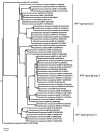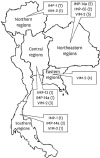1. Boucher HW, Talbot GH, Bradley JS, Edwards JE, Gilbert D, Rice LB, Scheld M, Spellberg B, Bartlett J. Bad bugs, no drugs: no ESKAPE! An update from the Infectious Diseases Society of America. Clin Infect Dis. 2009; 48:1–12.

3. Santajit S, Indrawattana N. Mechanisms of antimicrobial resistance in ESKAPE pathogens. Biomed Res Int. 2016; 2016:2475067.

4. Pérez-Losada M, Cabezas P, Castro-Nallar E, Crandall KA. Pathogen typing in the genomics era: MLST and the future of molecular epidemiology. Infect Genet Evol. 2013; 16:38–53.

5. Curran B, Jonas D, Grundmann H, Pitt T, Dowson CG. Development of a multilocus sequence typing scheme for the opportunistic pathogen
Pseudomonas aeruginosa
. J Clin Microbiol. 2004; 42:5644–5649.

6. Oliver A, Mulet X, López-Causapé C, Juan C. The increasing threat of Pseudomonas aeruginosa high-risk clones. Drug Resist Updat. 2015; 21-22:41–59.
7. Ji J, Wang J, Zhou Z, Wang H, Jiang Y, Yu Y. Multilocus sequence typing reveals genetic diversity of carbapenem- or ceftazidime-nonsusceptible
Pseudomonas aeruginosa in China. Antimicrob Agents Chemother. 2013; 57:5697–5700.

8. Feng W, Sun F, Wang Q, Xiong W, Qiu X, Dai X, Xia P. Epidemiology and resistance characteristics of
Pseudomonas aeruginosa isolates from the respiratory department of a hospital in China. J Glob Antimicrob Resist. 2017; 8:142–147.

9. Chen Y, Sun M, Wang M, Lu Y, Yan Z. Dissemination of IMP-6-producing
Pseudomonas aeruginosa ST244 in multiple cities in China. Eur J Clin Microbiol Infect Dis. 2014; 33:1181–1187.

10. Kouda S, Ohara M, Onodera M, Fujiue Y, Sasaki M, Kohara T, Kashiyama S, Hayashida S, Harino T, Tsuji T, Itaha H, Gotoh N, Matsubara A, Usui T, Sugai M. Increased prevalence and clonal dissemination of multidrug-resistant
Pseudomonas aeruginosa with the
blaIMP-1 gene cassette in Hiroshima. J Antimicrob Chemother. 2009; 64:46–51.

11. Cho HH, Kwon KC, Sung JY, Koo SH. Prevalence and genetic analysis of multidrug-resistant Pseudomonas aeruginosa ST235 isolated from a hospital in Korea, 2008-2012. Ann Clin Lab Sci. 2013; 43:414–419.
12. Kim MJ, Bae IK, Jeong SH, Kim SH, Song JH, Choi JY, Yoon SS, Thamlikitkul V, Hsueh PR, Yasin RM, Lalitha MK, Lee K. Dissemination of metallo-beta-lactamase-producing Pseudomonas aeruginosa of sequence type 235 in Asian countries. J Antimicrob Chemother. 2013; 68:2820–2824.

13. Falagas ME, Koletsi PK, Bliziotis IA. The diversity of definitions of multidrug-resistant (MDR) and pandrug-resistant (PDR)
Acinetobacter baumannii and
Pseudomonas aeruginosa. J Med Microbiol. 2006; 55:1619–1629.

14. Khuntayaporn P, Montakantikul P, Mootsikapun P, Thamlikitkul V, Chomnawang MT. Prevalence and genotypic relatedness of carbapenem resistance among multidrug-resistant P. aeruginosa in tertiary hospitals across Thailand. Ann Clin Microbiol Antimicrob. 2012; 11:25.
15. Picão RC, Andrade SS, Nicoletti AG, Campana EH, Moraes GC, Mendes RE, Gales AC. Metallo-beta-lactamase detection: comparative evaluation of double-disk synergy versus combined disk tests for IMP-, GIM-, SIM-, SPM-, or VIM-producing isolates. J Clin Microbiol. 2008; 46:2028–2037.

16. Cornaglia G, Giamarellou H, Rossolini GM. Metallo-beta-lactamases: a last frontier for beta-lactams? Lancet Infect Dis. 2011; 11:381–393.
17. Shibata N, Doi Y, Yamane K, Yagi T, Kurokawa H, Shibayama K, Kato H, Kai K, Arakawa Y. PCR typing of genetic determinants for metallo-beta-lactamases and integrases carried by gram-negative bacteria isolated in Japan, with focus on the class 3 integron. J Clin Microbiol. 2003; 41:5407–5413.

18. Edgar RC. MUSCLE: multiple sequence alignment with high accuracy and high throughput. Nucleic Acids Res. 2004; 32:1792–1797.

19. Stamatakis A. RAxML version 8: a tool for phylogenetic analysis and post-analysis of large phylogenies. Bioinformatics. 2014; 30:1312–1313.

20. Bush K, Jacoby GA. Updated functional classification of beta-lactamases. Antimicrob Agents Chemother. 2010; 54:969–976.
21. Kazmierczak KM, Rabine S, Hackel M, McLaughlin RE, Biedenbach DJ, Bouchillon SK, Sahm DF, Bradford PA. Multiyear, Multinational survey of the incidence and global distribution of metallo-beta-lactamase-producing
Enterobacteriaceae and
Pseudomonas aeruginosa. Antimicrob Agents Chemother. 2015; 60:1067–1078.

22. Boonkerd N, Pibalpakdi P, Tiloklurs M, Niumsup PR. Class 1 integron containing metallo beta-lactamase gene
blaIMP-1 in carbapenem-resistant
Pseudomonas aeruginosa in Thailand. J Infect Chemother. 2009; 15:257–261.

23. Piyakul C, Tiyawisutsri R, Boonbumrung K. Emergence of metallo-beta-lactamase IMP-14 and VIM-2 in Pseudomonas aeruginosa clinical isolates from a tertiary-level hospital in Thailand. Epidemiol Infect. 2012; 140:539–541.

24. Rimrang B, Chanawong A, Lulitanond A, Wilailuckana C, Charoensri N, Sribenjalux P, Phumsrikaew W, Wonglakorn L, Kerdsin A, Chetchotisakd P. Emergence of NDM-1- and IMP-14a-producing Enterobacteriaceae in Thailand. J Antimicrob Chemother. 2012; 67:2626–2630.
25. Prombhul S, Tribuddharat C, Laikijrung P, Aranya C, Bamrungsri N, Mekviwattanawong S. New variant of an imipenemase,
IMP-32, in
Klebsiella pneumoniae from a fatal case of a Thai patient. J Med Microbiol. 2016; 65:572–573.

26. Zhao WH, Hu ZQ. Acquired metallo-beta-lactamases and their genetic association with class 1 integrons and ISCR elements in Gram-negative bacteria. Future Microbiol. 2015; 10:873–887.

27. Zhao WH, Hu ZQ. IMP-type metallo-beta-lactamases in Gram-negative bacilli: distribution, phylogeny, and association with integrons. Crit Rev Microbiol. 2011; 37:214–226.

28. Mano Y, Saga T, Ishii Y, Yoshizumi A, Bonomo RA, Yamaguchi K, Tateda K. Molecular analysis of the integrons of metallo-beta-lactamase-producing Pseudomonas aeruginosa isolates collected by nationwide surveillance programs across Japan. BMC Microbiol. 2015; 15:41.
29. Samuelsen O, Toleman MA, Sundsfjord A, Rydberg J, Leegaard TM, Walder M, Lia A, Ranheim TE, Rajendra Y, Hermansen NO, Walsh TR, Giske CG. Molecular epidemiology of metallo-beta-lactamase-producing
Pseudomonas aeruginosa isolates from Norway and Sweden shows import of international clones and local clonal expansion. Antimicrob Agents Chemother. 2010; 54:346–352.

30. Koh TH, Khoo CT, Tan TT, Arshad MA, Ang LP, Lau LJ, Hsu LY, Ooi EE. Multilocus sequence types of carbapenem-resistant
Pseudomonas aeruginosa in Singapore carrying metallo-beta-lactamase genes, including the novel
blaIMP-26 gene. J Clin Microbiol. 2010; 48:2563–2564.

31. Wright LL, Turton JF, Hopkins KL, Livermore DM, Woodford N. Genetic environment of metallo-beta-lactamase genes in Pseudomonas aeruginosa isolates from the UK. J Antimicrob Chemother. 2015; 70:3250–3258.
32. Fan X, Wu Y, Xiao M, Xu ZP, Kudinha T, Bazaj A, Kong F, Xu YC. Diverse genetic background of multidrug-resistant
Pseudomonas aeruginosa from Mainland China, and emergence of an extensively drug-resistant ST292 clone in kunming. Sci Rep. 2016; 6:26522.

33. Lee JY, Song JH, Ko KS. Identification of nonclonal
Pseudomonas aeruginosa isolates with reduced colistin susceptibility in Korea. Microb Drug Resist. 2011; 17:299–304.

34. Santella G, Pollini S, Docquier JD, Mereuta AI, Gutkind G, Rossolini GM, Radice M. Intercontinental dissemination of IMP-13-producing
Pseudomonas aeruginosa belonging in sequence type 621. J Clin Microbiol. 2010; 48:4342–4343.








 PDF
PDF ePub
ePub Citation
Citation Print
Print





 XML Download
XML Download